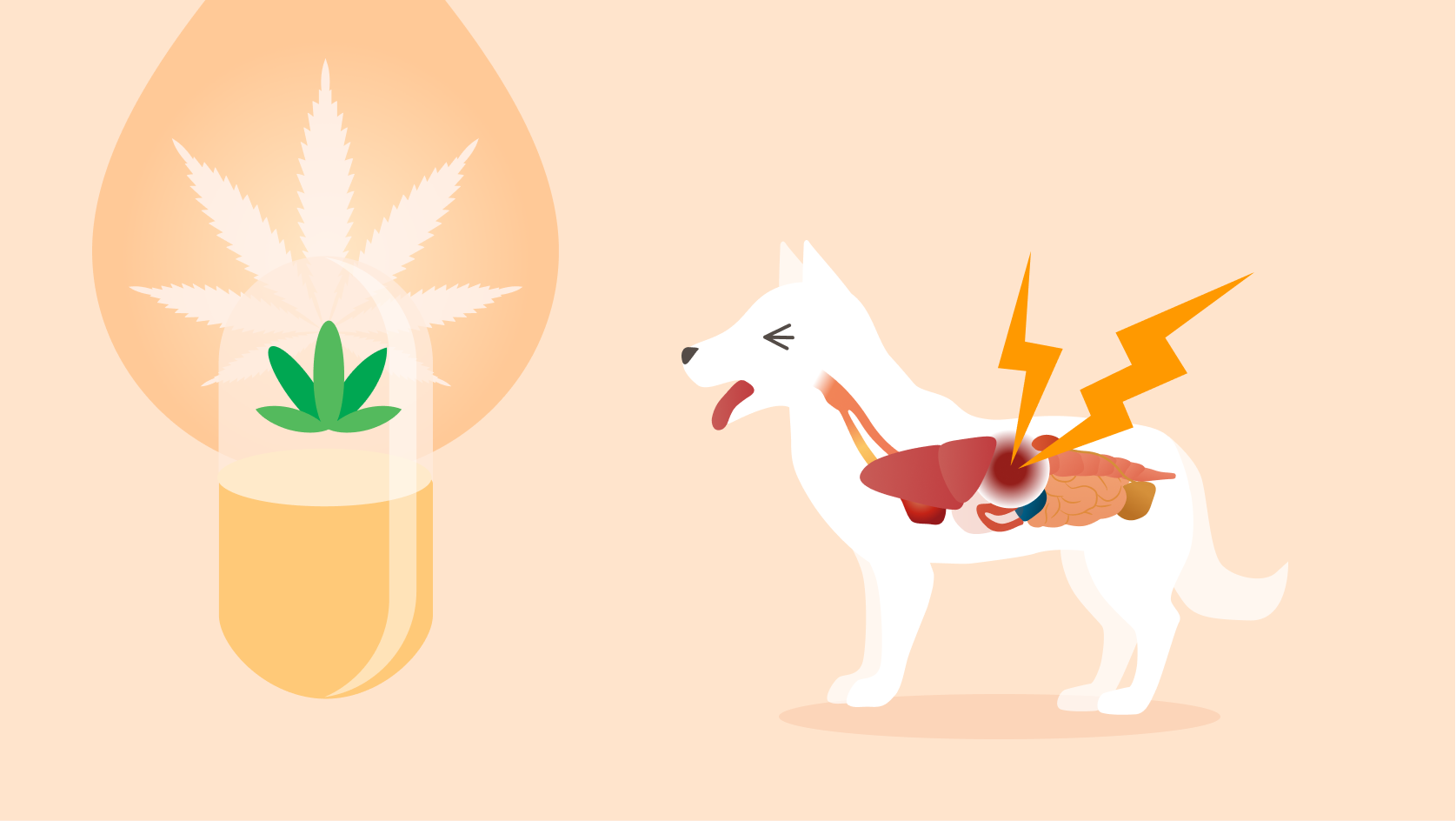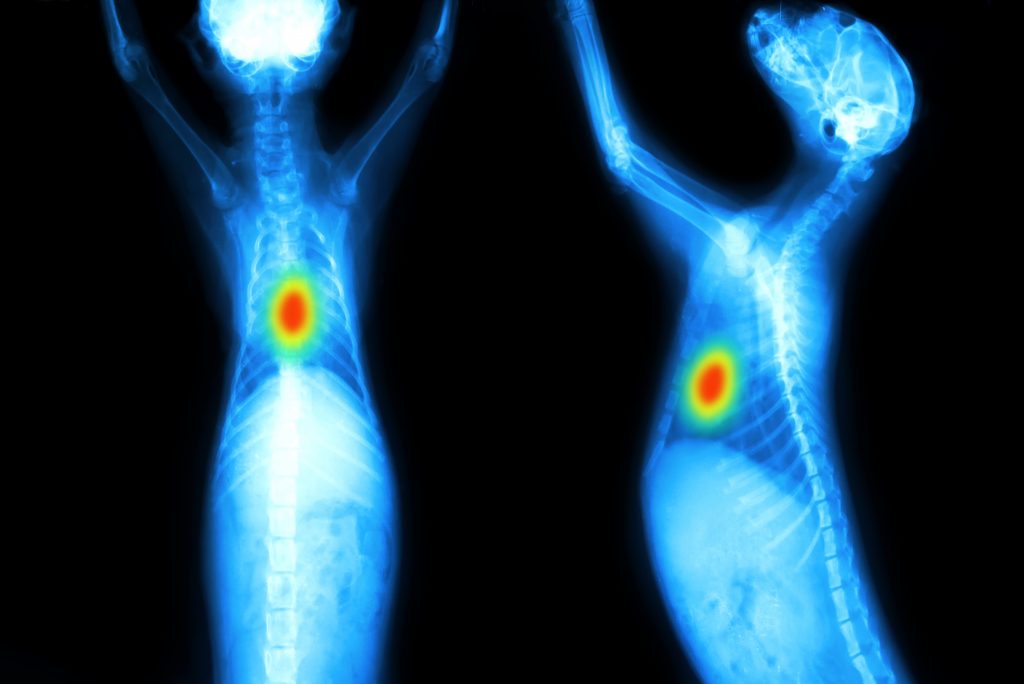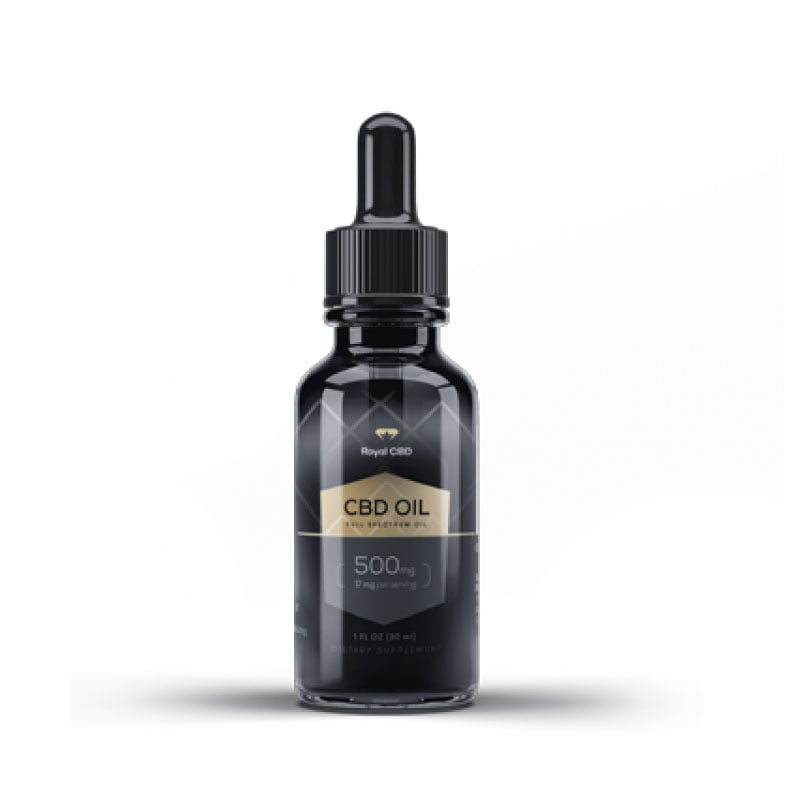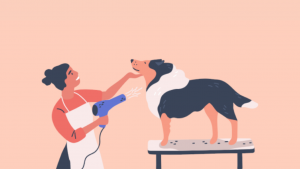| Total CBD: | 250 – 500 mg |
| Potency: | 8.3 – 16.6 mg/mL |
| Cost per mg: | $0.18 – $0.24 |
| Extract type: | Full-spectrum |
| Flavor: | Bacon |

Evidence based
CBD Oil For Dogs With Cancer: Benefits, Safety, & Current Research
According to the Veterinary Cancer Society, roughly 1 in 4 dogs will develop cancer at some point in their life.
Learn how people are using CBD oil to help their dogs cope with the side-effects of cancer therapy.
Cancer treatment is available for pets — but it’s expensive, comes with a myriad of other side effects, and isn’t always effective. Only about 50% of cancers are curable.
CBD oil is a popular adjunctive treatment for cancer therapy in dogs for two reasons — it alleviates most of the common side-effects of cancer therapy, and there’s some evidence to suggest it can slow the growth of cancer.
Learn how pet owners are using CBD oil for cancer in their dogs.
I’ll cover how it works, what the research says, what dose to use, and where to find the best CBD oils for the job.
Let’s start with the top 5 best CBD oils for dogs with cancer in 2020.
Best CBD Oils For Dogs With Cancer
- Royal CBD Pet Oil — Best CBD Pet Oil Overall
- Honest Paws CBD Oil For Dogs (Mobility) — CBD Oil With Turmeric
- Austin & Kat (Brady’s Senior Formula) — Best CBD Oil For Older Dogs
- HolistaPet CBD Oil For Dogs & Cats — Best CBD Oil For Cats or Dogs With Cancer
The Benefits of CBD Oil For Dogs With Cancer
Cannabis has been used as a cancer-supportive herb for thousands of years.
In fact, one of the primary drivers behind the change in public opinion about cannabis comes from its role in helping cancer patients manage the destructive side effects of cancer therapy.
Today, most of the focus on the benefits of cannabis products for cancer come from the clinical trials of three cannabis-based pharmaceuticals — Dronabinol, Nabilone, and Sativex.
Each of these medications is made from either CBD, THC, or a combination of the two.
While nothing is conclusive, the results from studying these drugs on cancer are promising. There are several prominent benefits cannabinoids like CBD may offer both human and canine cancer patients.
The benefits of CBD oil for cancer in dogs include:
- May help the immune system detect cancer cells faster
- Alleviates cancer-related pain
- Alleviates common side-effects of cancer therapy (diarrhea, nausea, insomnia)
- May slow the growth of cancerous tumors
1. Supports Immune Function
Your dogs’ immune system is always on the lookout for anything that looks out of the ordinary — this includes invading pathogens like viruses and bacteria, as well as abnormal cells such as cancer.
The specific immune cells that look for signs of cancer include the natural killer (NK) and T-lymphocytes [1].
The connection between CBD and cancer detection is very complex — researchers are still seeking to understand how it works. So far, what we know is that CBD interacts with the CB2 endocannabinoid receptors — which are present on both NK and T-cells. It’s believed that CBDs regulatory benefits on the CB2 receptors play a key role in its cancer-preventative benefits.
A Polish study published in 2017 found that CBD caused a shift in immune activation from TH2 (commonly seen in cancer patients) to TH1 (thought to be better for cancer prevention) [2].
The TH1 and TH2 balance is very complicated. There have been entire textbooks written on the subject. Here’s a brief summary of how TH1 and TH2 compare:
- TH1 immune response — better for attacking pathogens like viral and bacterial particles and cancer, but also involved with autoimmune reactions
- TH2 immune response — more involved in maintaining inflammation and allergies
2. Alleviates Cancer-Related Pain
Chronic pain is a common and debilitating side effect of cancer.
Cancer can cause pain by damaging nerve cells and triggering inflammatory reactions. Tumor growth can also begin to press on surrounding organs or tissues — causing pain or discomfort.
Chemotherapy can also lead to chronic pain in dogs by damaging nerve cells and causing widespread oxidative damage.
Studies have shown that both CBD and THC are effective for eliminating cancer-related pain [3]. These results were especially notable because the patients in this study were unable to treat their pain using conventional opioid pain medications first.
This study was conducted on humans, but the concept behind how it works can be applied to dogs as well.
3. Supports Side-Effects of Cancer-Therapy
The primary treatments for cancers in dogs are chemotherapy or radiotherapy (or a combination of both).
These treatments are aggressive and can cause a lot of damage to the body. As a result, there are a lot of negative side-effects associated with these medications.
Common side-effects of cancer-therapy include:
- Nausea & vomiting
- Insomnia
- Eczema
- Lack of appetite
- Fatigue
- Headaches
CBD has been shown on separate occasions to support most of these side effects, with the most noteworthy improvement in symptoms such as nausea, insomnia and headaches.
The most common reasons pet owners use CBD products with their dogs are to alleviate these side effects — rather than for treating the cancer directly. The ultimate goal of using CBD oil for this purpose is to improve your dogs’ quality of life so taking steps to mitigate symptoms is a key component of cancer-supportive therapy.
4. May Slow the Growth of Tumors
There’s been numerous in vitro and animal studies that have demonstrated the anticancer effects of cannabinoids, including CBD and THC [4] — however, the evidence is inconclusive. CBD has been shown to inhibit the growth of cancerous tumors in some cancers and not in others.
While tumor suppression is a promising benefit of CBD, it’s not something we can rely on quite yet until there’s more evidence to back this up.

How to Use CBD Oil With Dogs With Cancer
Using CBD oils with dogs is very straightforward. The easiest way to give your dog CBD is to mix some in with their food.
You shouldn’t expect results from the CBD oil right away. Give your dog a dose of CBD twice per day, with meals. It will be a few days before you’ll start to see any noticeable improvements.
The first sign of improvements will be a reduction in pain or nausea symptoms, but the other benefits (cancer suppression and immunomodulation) require several weeks or months of regular use to take effect. It’s important to be patient and persistent.
Some picky dogs may avoid their food after you’ve added CBD oil, so you’ll need to drop a dose of the oil directly into their mouths instead. Once you’ve squirted some CBD into their mouth, you’ll need to hold their mouth closed for a few seconds to make sure they swallow the entire dose.
This won’t hurt your dog and is the standard method vets use to give dogs oral medications.
Before you decide to use CBD oil with your dog to support cancer, it’s wise to speak with your vet. Some medications or other underlying health issues could interact with CBD and make symptoms worse.
Related: Can CBD Oils Help Dogs With Arthritis?
What’s the Dose of CBD Oil For Dogs With Cancer?
The dose of CBD is highly dependant on the size of your dog. Other factors can also affect the dose — such as the breed, severity of symptoms. Even the health of their digestive tract plays a role. Dogs with poor digestion absorb less CBD oil and may need a higher dose.
There are two potency levels when it comes to giving CBD oil to dogs:
- Low-potency dose — 1 mg of CBD per kg of bodyweight
- High-potency dose — 2 mg of CBD per kg of bodyweight
For cancer-related side-effects, a high dose is recommended. Many of the studies that have shown benefit from using CBD for cancer used doses much higher than this (5 mg/kg by injection) [5].
If using CBD oil for the first time with your dog, start with a very low dose first to make sure there are no allergies or other negative reactions first.
Once you know your dog can handle CBD oil safely, try and bring them up to the high dose according to their weight class.
Monitor your dog to see how they respond, and increase or decrease the dose slightly each day accordingly.
CBD Dosage Chart For Dogs With Cancer
| Dog Size & Weight | Dosage Range(Low-Dose) | Dosage Range (High-Dose) | Recommended CBD Oil Potency | |
| Very Small Dogs (2-15 lbs) | 1 – 7 mg | 2 – 14 mg | 150 mg CBD Oil | |
| Small Dogs (15-30 lbs) | 7 – 14 mg | 14 – 28 mg | 300 mg CBD Oil | |
| Medium Dogs (30-60 lbs) | 14 – 27 mg | 28 – 54 mg | 300 – 600 mg CBD Oil | |
| Large Dogs (60-150 lbs) | 27 – 60 mg | 54 – 120 mg | 600 – 1500 mg CBD Oil |
Is CBD Oil Safe For Dogs?
There have already been thousands of animal studies and clinical trials on humans involving CBD at every dosage imaginable. Additionally, millions of people are using CBD oils with their dogs on a daily basis without any issues.
Even at very high doses (600 mg), CBD has been shown to pose little risk to the participants of this research. There are a few side effects that have been reported, but these tend to be mild in nature (nausea or fatigue).
With that said, it’s important to monitor any changes in your dog after giving them CBD — especially the first couple of doses.
Some dogs may experience an allergic reaction to the CBD or other ingredients in the oil. Allergies can present with mild symptoms like sneezing or coughing or more severe side effects like difficulty breathing and fainting.
It’s also important to watch out for potential side effects of CBD oil and reduce the dose if necessary, to avoid them in the future.
The most common side-effects of CBD oil in dogs include:
- Lethargy — your dog may be sleeping more than usual
- Nausea & vomiting — signs of nausea include excessive drooling
- Dizziness or lightheadedness — your dog may not want to move or get up from lying down

What Kind of Cancer Can Dogs Get?
Dogs are susceptible to all the same cancers as humans.
The most common type of cancer in dogs is lymphoma — accounting for up to 20% of all cases. Compared to humans, dogs are roughly 5x more likely to develop this type of cancer.
The most common forms of cancers in dogs include:
- Mast Cell Tumors — can occur anywhere in the body but usually identified in the skin
- Lymphoma — cancer of the lymph nodes
- Osteosarcoma — bone cancer
- Melanoma — an aggressive form of skin cancer (can also occur in the eye)
- Mammary gland carcinomas — cancer of the mammary glands in female dogs
- Hemangiosarcoma — cancer of the blood vessels
- Brain Cancer — there are several different forms of brain cancer
- Liver Cancer — there are several different types of liver cancer
- Lipoma — cancer that forms just below the surface of the skin
- Lung Cancer — lung cancers come in many different forms
Cancer In Dogs: Signs & Conventional Treatments
Cancer is relatively common in dogs — especially older dogs. Some reports suggest that nearly 50% of dogs over the age of 10 will receive a cancer diagnosis.
There are hundreds of different types of cancer — each one presenting with different symptoms. Some cancers are easy to spot — others can go unnoticed for months or years.
If you notice any strange lumps, skin lesions or find your dog has been abnormally tired or low-energy for the past couple of weeks, it’s a good idea to visit your vet to investigate.
Most cancers will require some testing to identify. Your vet will run imaging tests, biopsies, or blood panels to check for signs of cancer.
Common Signs of Cancer in Dogs
- Lumps or masses
- Skin lesions that won’t heal or go away
- Persistent vomiting or diarrhea
- Loss of appetite or weight loss
- Lethargy or low-energy
- Difficulty with urination or defecation
Risk Factors For Cancer in Dogs:
What causes cancer in dogs?
Older dogs are most at risk of developing cancer, but it can occur at any stage of life. Around the ten-year age mark, the risk of cancer becomes much more significant.
Risk factors that can increase the odds of developing cancer in dogs include:
- Age (older dogs have a higher risk)
- Breed
- Exposure to carcinogens (such as road salt or pesticides)
- Poor diet
- Radiation exposure
- Genetic polymorphisms

Prevalence of Cancer by Dog Breed
Certain breeds of dogs are also more at risk for developing cancer than others.
A large study published in 2013 looked at the cause of death in 2000 dogs to identify the rates of cancer for different dog breeds [6].
This study reported that roughly 27% of deaths were cancer-related.
Cancer Rates For 66 Dogs Breeds
- Irish water spaniel — 55.8%
- Flat-coated retriever — 50.3%
- Hungarian wirehaired vizsla — 46.7%
- Bernese mountain dog — 45.7%
- Rottweiler — 45.3%
- Leonberger — 44.7%
- Italian Spinone — 44.7%
- Staffordshire bull terrier — 44.4%
- Welsh terrier — 43.5%
- Giant schnauzer — 41.0%
- Airedale terrier — 39.5%
- Golden retriever — 38.8%
- Boxer — 38.5%
- French bulldog — 38.0%
- Briard — 38.0%
- Bullmastiff — 37.5%
- Alaskan Malamute — 35.7%
- Saluki/gazelle hound — 35.6%
- Nova Scotia duck tolling retriever — 33.3%
- Basset griffon vendeen — 32.9%
- English setter — 32.8%
- Beagle — 32.8
- Norwegian elkhound — 32.4%
- Siberian Husky — 31.8%
- Keeshond — 31.7%
- Tibetan terrier — 31.6%
- Labrador retriever — 31.2%
- Basset hound — 31.0%
- Afghan hound — 30.8%
- Rhodesian ridgeback — 30.6%
- Irish red and white setter — 30.2%
- Standard poodle — 29.7%
- German shorthaired pointer — 29.6%
- Field spaniel — 29.4%
- Cocker spaniel/English cocker — 29.4%
- Gordon setter — 29.3%
- Welsh corgi Pembroke — 28.4%
- Welsh corgi cardigan — 28.3%
- Irish setter — 27.3%
- Newfoundland — 27.1%
- Welsh springer spaniel — 26.8%
- English springer spaniel — 26.7%
- Lancashire heeler — 26.7%
- Samoyed — 26.5%
- Soft-coated wheaten terrier — 26.1%
- Doberman — 26.0%
- German wirehaired pointer — 24.4%
- Border collie — 23.6%
- Tibetan spaniel — 23.2%
- Bull terrier — 23.0%
- Belgian shepherd — 23.0%
- Shetland sheepdog — 22.3%
- Manchester terrier — 21.9%
- Miniature schnauzer — 21.5%
- Norwich terrier — 21.4%
- Finnish spitz — 21.4%
- Pointer — 20.7%
- Cairn terrier — 19.4%
- Bearded Collie — 19.4%
- Border terrier — 19.2%
- Dalmatian — 19.1%
- Sussex spaniel — 19.0%
- Deerhound — 18.8%
- Bulldog/British bulldog — 18.3%
- Dachshund (all) — 16.7%
- Shih Tzu — 14.5%
How is Cancer Diagnosed For Dogs?
Your vet will use different tools to diagnose your dog with cancer.
Visible skin lesions or lumps are biopsied, which involved cutting out a section and analyzing it in a lab.
Other forms of cancer require more investigative work. Vets can order X-rays or other imaging tests to look for masses or tumors inside the body, and blood tests can be used to check for blood cancer or other signs of cancer.
Conventional Cancer Treatments for Dogs
The type of cancer your dog is diagnosed with will determine the treatment. Some forms of cancer are much more difficult to treat than others.
It’s important to speak with your vet about your treatment options. Some forms of cancer are easily treated, while others are much more difficult.
In some cases, your vet may recommend forgoing cancer therapy and address the underlying side effects instead. If the prognosis is bleak, treating the disease will only lead to a reduced quality of life in the final days for your dog. So instead, your vet may prescribe painkillers and anxiolytics as symptom management only and wait out the disease.
The most common treatments for cancer in dogs include:
- Surgery — physical removal of the cancerous tumors and surrounding tissue
- Radiation therapy — involves exposing the cancerous tissue to ionizing radiation
- Chemotherapy — this is a class of drugs that destroys certain types of cancer cells
- Combination therapy — in most cases, treatment involves a combination of two or all three of these treatments (surgical removal, radiotherapy, and chemotherapy)
Key Takeaways: Best CBD Oils For Dogs With Cancer
While CBD oil is not a cure for cancer, it does offer a variety of useful benefits for pet owners looking to support the quality of life in dogs with cancer and may offer protective mechanisms that could improve their odds of survival.
The main effects of CBD oil for cancer rely on its painkilling, anti-nausea, and immunomodulating benefits.
The best CBD oils or dogs with cancer are made with a full-spectrum extract, come in relatively high doses, and come in a variety of potency options so you can match it with the size of your dog. Most research suggests the dose of CBD oils for cancer is around 2 mg/kg or higher (high-dose).
It’s important you speak with a vet before giving your dog CBD oil to support cancer and be patient and persistent with the dose for optimal benefit. The greatest benefit of CBD oil comes from long-term use.
References Cited in This Article
- Schoorl, R., Riviere, A. B., Borne, A. E., & Feltkamp-Vroom, T. (1976). Identification of T and B lymphocytes in human breast cancer with immunohistochemical techniques. The American journal of pathology, 84(3), 529.
- Śledziński, P., Zeyland, J., Słomski, R., & Nowak, A. (2018). The current state and future perspectives of cannabinoids in cancer biology. Cancer medicine, 7(3), 765-775.
- Johnson, J. R., Burnell-Nugent, M., Lossignol, D., Ganae-Motan, E. D., Potts, R., & Fallon, M. T. (2010). Multicenter, double-blind, randomized, placebo-controlled, parallel-group study of the efficacy, safety, and tolerability of THC: CBD extract and THC extract in patients with intractable cancer-related pain. Journal of Pain and symptom management, 39(2), 167-179.
- Sharafi, G., He, H., & Nikfarjam, M. (2019). Potential use of cannabinoids for the treatment of pancreatic cancer. Journal of Pancreatic Cancer, 5(1), 1-7.
- McAllister, S. D., Murase, R., Christian, R. T., Lau, D., Zielinski, A. J., Allison, J., … & Liu, Y. (2011). Pathways mediating the effects of cannabidiol on the reduction of breast cancer cell proliferation, invasion, and metastasis. Breast cancer research and treatment, 129(1), 37-47.
- Dobson, J. M. (2013). Breed-predispositions to cancer in pedigree dogs. International Scholarly Research Notices, 2013.











